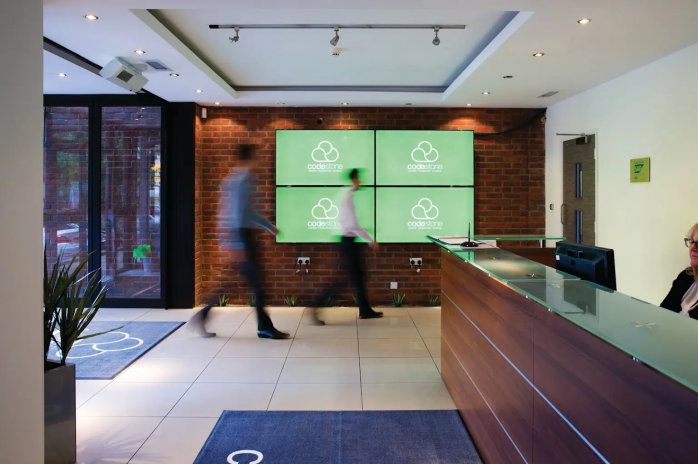According to the World Economic Forum (WEF), manufacturing accounts for 27.5% of global cyberattacks. It has been the most targeted sector by cybercriminals for the last three years in a row.
Manufacturers are vulnerable because, as the WEF puts it, they have a “relatively low level of cyber maturity compared to other sectors.” In other words, their operations are increasingly digitally driven, but their cybersecurity processes often lag behind.
The sector’s vulnerability to cyberattack is not sustainable. Manufacturers need to make cybersecurity a priority and keep bad actors at bay. In the rest of this piece we’ll detail the cyberthreats manufacturers face, and outline a five-step plan to cyber-safety.
5 Cyberthreats Manufacturers Need To Know About
The threats manufacturers face come from several directions.
1) Downtime and Disruption
Digital systems are complex and connected. A successful attack in a manufacturing setting can cause equipment and machinery to freeze and malfunction. In fact, one of the reasons criminals target manufacturers with ransomware so routinely is because of the sector’s low tolerance to downtime. To put it another way, the costs of stalled production lines are so potentially catastrophic that manufacturers often pay the ransom.
2) Legacy Systems
Manufacturers are naturally keen to squeeze as much value as possible out of expensive systems and machinery. But the older the equipment, the more vulnerable it can be to cyberattack. Legacy systems are difficult to upgrade and patch (they may no longer be supported), and the most modern protections are often lacking.
3) Regulatory and Client Pressures
Threats are not just criminal. Regulators are increasingly stringent when it comes to the appliance of cybersecurity measures. The UK NIS2 Directive is a case in point. Clients and the wider supply chain may also pressure manufacturers to adopt tighter cybersecurity measures. Those that refuse could face financial and reputational damage, and may lose customers.
4) Third-Party Risks
Manufacturers are often in the middle of complex supply chains, buying components from third parties and selling finished goods to customers. A vulnerability in any link in the chain could give hackers a backdoor into your systems and data. SMEs often lack the resources to vet cybersecurity standards in every partner they do business with.
5) Employee Risks
As far as cyber risk goes, you’re only as secure as your most slapdash employee. Criminals target your people through phishing and social engineering attacks; absent-mindedly clicking an email link could allow malware to spread across your digital estate. In manufacturing, non-technical staff often lack necessary cybersecurity awareness.
5 Steps to Cyber Peace of Mind
These threats can seem daunting, but there are ways of quickly and easily adding extra security measures to your IT stack. The challenge manufacturers often have is balancing security and operational efficiency. In this five step cybersecurity plan, we’ll help you secure your systems without undermining your operations.
1) Understand Your “Attack Surface”
The first step to cyber safety is knowing what, exactly, is open to attack. Identify and map anything that interacts with the online world. That can mean hardware, software, cloud systems, data, network infrastructure, Internet of Things devices and more. It should also include people, which means permanent or temporary staff, contractors and employees that are leaving.
2) Identify Your Threats
We’ve listed some of the most common threats above, but what are the most likely vulnerabilities in your own business? For example, do you operate legacy systems or equipment? Do you work with suppliers in countries with less stringent cybersecurity standards? When was the last time your employees had a cybersecurity refresher? In this way you can identify and prioritise your most pressing cybersecurity challenges.
3) Analyse Your Networks
Manufacturers often add in new machinery or processes in quite a piecemeal way, making incremental improvements to performance and efficiency. But that can also lead to increasingly complex connections between the equipment in your network, and systems of various ages and security standards working together. Prioritise risk assessments and continual monitoring.
4) Make a Plan
You can’t cover everything, or at least not all once. Using the threats identified earlier, make a list of the vulnerabilities that need to be tackled straight away, and those that can safely be left till later. There’s no such thing as completely unbreachable cybersecurity, so don’t let perfection be the enemy of good. Your priorities should reflect real risk. In short, tackle your biggest vulnerability first.
5) Take Action
When you’ve mapped your attack surfaces, identified and prioritised vulnerabilities, and completed any relevant risk assessments, it’s time to act. Do the basics straight away. Cybersecurity awareness training is one way to efficiently cover a lot of bases, because human error is the cause of a large number of security breaches. Put two factor authentication policies in place. Restrict IT admin rights to those who really need them. Create a password policy. Back-up data. After that, you can get into the weeds of supplier management, virtual private networks and more.
Understand your cybersecurity risk
The most important thinking is to understand the risk you face. Last year, a German battery manufacturer had to halt production at five plants for two weeks because of a cyberattack. Imagine what a two-week layoff could do to your business, and then start the process of making cybersecurity a core component of your operational strategy.
Codestone offers CyberCare, a comprehensive cybersecurity services that gives you peace of mind. We deploy cutting-edge solutions to fortify your enterprise against evolving threats. We will monitor your network, assess your risk, and empower your business to forge ahead with confidence.
Act now and talk to us today.










































































